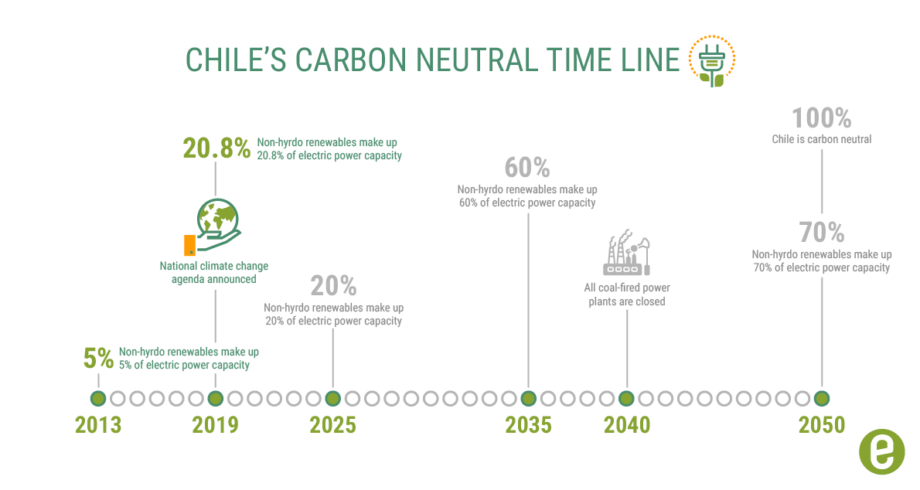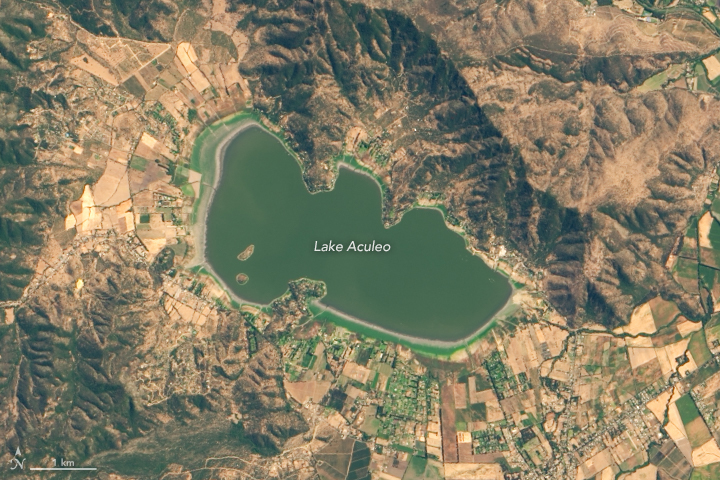September 24, 2019 —  Late last year, when Brazil bowed out of hosting the United Nations’ 2019 COP 25 climate talks, Chilean environment minister Carolina Schmidt proposed to her climate change team that Chile pick up the ball. The team replied “no chance” — it would be too much to take on. Determined, Schmidt reached out to President Sebastián Piñera. Citing the opportunity to be a sustainable development leader, Piñera gave Schmidt the go-ahead.
Late last year, when Brazil bowed out of hosting the United Nations’ 2019 COP 25 climate talks, Chilean environment minister Carolina Schmidt proposed to her climate change team that Chile pick up the ball. The team replied “no chance” — it would be too much to take on. Determined, Schmidt reached out to President Sebastián Piñera. Citing the opportunity to be a sustainable development leader, Piñera gave Schmidt the go-ahead.
Stepping in as COP 25 host is just one in a series of actions that suggest Chile is emerging as a global climate leader. In June 2019, Piñera launched an ambitious national climate change agenda. Chile plans to close its 28 coal-fired power plants by 2040. It proposes to fill the resulting 40% gap in its electricity mix, plus all future growing demand, with renewable energy — with the goal of achieving carbon neutrality by 2050.
“Being the host of the summit puts the eyes of the world on what the country is doing to be consistent between discourse and action to address the challenge of climate change,” says Matías Asun, director of Greenpeace Chile.
Indeed, Chile is taking concerted action at a clip and with a vigor not seen in most other countries. As the U.S., Brazil and other prominent nations backtrack on previous commitments, the Piñera administration is painting climate change action as a bipartisan, common-sense opportunity for growth.
Could Chile’s practical, pro-business approach to addressing climate change inspire global action to meet the Paris Agreement goals and limit warming to 1.5 °C (2.7 °F)? Some think the country’s fresh perspective might be just what we need to lead the way.
Renewable Energy: The Catalyst for Change
In 2013, renewables made up just 5% of Chile’s electric power capacity, with the rest coming from coal, natural gas and hydroelectricity (the last of which is not considered a renewable energy source in national policy). By 2019 that number had risen to 20.8%, which is ahead of schedule to meet the goal of 20% electricity production from non-hydro renewable sources by 2025. The country is well on the way to meet additional goals of 60% by 2035 and 70% by 2050. The Chilean National Electricity Coordinator predicts that this year solar energy (9.4%) will overtake natural gas (8.6%) as a larger share of the Chilean electricity mix.
 Why the transformation? While Chile holds virtually no coal or gas deposits, it is bountiful in sunny deserts, windy coasts, volcanic hot spots and cascading water. Thanks to rapid technology change, plummeting renewable energy generation costs and international investment, expensive dependence on imported fossil fuels is giving way to increased reliance on abundant domestic renewable energy resources.
Why the transformation? While Chile holds virtually no coal or gas deposits, it is bountiful in sunny deserts, windy coasts, volcanic hot spots and cascading water. Thanks to rapid technology change, plummeting renewable energy generation costs and international investment, expensive dependence on imported fossil fuels is giving way to increased reliance on abundant domestic renewable energy resources.
In fact, this small nation envisions an even bigger future — one in which it attains energy security and independence and reaps the political and economic benefits of exporting clean energy to its neighbors.
“Nobody expected this technological change,” Susana Jiménez, Chile’s former minister of energy, recently told the Columbia Energy Exchange. “It’s just good news for us. It’s an opportunity to explore our potential, to have access to cheaper energy — and why not to think about exporting our clean energy to our neighboring countries?”
Reducing Vulnerability
Chile’s decarbonization may be born of a capitalist drive, but it’s also hastened by a fear of cataclysms that a warmer, more volatile future will bring.
Climate change has a tangible presence in the everyday lives of Chilean farmers, fishermen, business owners, students and everyone in between. In the past 10 years, the country has experienced a mega-drought, record-breaking wildfires, widespread glacial retreat and an uptick in extreme weather. And the World Resources Institute (WRI) predicts that by 2040, Chile will be the most water-stressed country in the western hemisphere.


“Chile is a very vulnerable country,” Jenny Santos, head of climate change mitigation for the Chilean government said in a webinar in August, “so it is very important for us to move forward to a better planning process regarding climate change.”
Indeed, Chile is spearheading regional planning and cooperation efforts to address climate change and environmental degradation. At the G7 meeting in late August that delivered an agreement for fire control and reforestation of the Amazon, Piñera mediated tensions between Brazilian president Bolsonaro and French president Macron.
“Taking action on climate change can provide extremely important economic and development outcomes for countries,” says David Waskow, director of WRI’s International Climate Initiative. By establishing a clear climate policy agenda, Waskow suggests, Piñera’s administration is providing the clarity and stability needed to spur investment and international cooperation and, ultimately, to build prosperity and resilience in the face of climate change.
COP 25: Opportunities for Progress
Historically, COP hosts have utilized the summit to unveil new, ambitious plans and celebrate their private and public sector efforts to address climate change.
The independent climate analytics group Climate Action Tracker rates Chile’s current Nationally Determined Contribution (NDC) carbon-reduction target — which has not been updated since 2017— as “highly insufficient.” At COP 25, the country plans to unveil a new, more ambitious NDC that includes its coal-phase out plan and other plans for decarbonization. Doing so would add another layer of accountability to the targets it has already announced.
Schmidt has emphasized that COP 25 must mark the shift from the negotiation to the implementation of global action on climate change. In this way, Waskow says, “Chile has a role now to help shape what the future of COPs will be.”
Beyond COP
As Chile works to advance its efforts in the climate arena, observers offer a number of suggestions for further progress.
Boost Energy Efficiency. Amanda Maxwell, director of the Natural Resources Defense Council (NRDC)’s Latin America Project, says that Chile has abundant opportunities to improve energy efficiency. “It’s the lowest hanging fruit if you want to reduce demand in the fastest way,” she says.
Decarbonize More Quickly. Maxwell and others say the country could phase out coal 10 years earlier than planned. “Their decarbonization plan is great, but they could do it faster,” she says.
Protect Activists. The Chilean government is drawing heat from local environmental groups for failing to sign the Escazú Agreement, a Latin American U.N. accord to protect environmental and climate change activists. “I know a lot of environmental groups have made a strong push [for the Chilean government to sign the agreement], but the government has not responded,” Maxwell says.
Engage the Mining Industry. The Chilean congress is currently embroiled in a debate on a national glacier protection law, which just last year was discussed and shut down by mining interests. Historically, the copper mining industry and environmental advocates have clashed on environmental protection and climate change issues. The debate is only becoming more complex as Chile’s lithium mining industry grows to feed the electric vehicle and renewable energy industries — which allow Chile to fulfill their climate commitments.
Consider Chinese Connections. Chinese investment in the Chilean economy, particularly in renewable energy and electric urban mobility, is widespread and profound. And Chile serves as Latin America’s “gateway” and primary connection for China’s Belt and Road Initiative for global connectivity and transportation — although Piñera recently voiced concerns amid growing criticisms of the initiative’s environmental track record. China’s reticence to address such concerns and present a concrete plan to meet its climate commitments at the September 23 U.N. Climate Action Summit leaves COP 25 as an important venue to illuminate the climate dimensions of the Chilean–Chinese relationship later this year.
The Bottom Line
Chile is forming a role for itself as a politically conservative climate change leader. In December at COP 25, the reality of if we’re on track to avoid the worst consequences of climate change will come into focus. How Chile defines and carries out climate-smart, sustainable development could set the tone for the rest of Latin America, and perhaps even inspire the rest of the world to follow suit.
Editor’s note: Kate Cullen wrote this story as a participant in the Ensia Mentor Program. The mentor for the project was Aleszu Bajak. Some of the interviews were conducted in Spanish and translated by the writer.
Editor’s note: Chile canceled plans to host COP 25 in late October due to domestic unrest.
Related Posts
Ensia shares solutions-focused stories free of charge through our online magazine and partner media. That means audiences around the world have ready access to stories that can — and do — help them shape a better future. If you value our work, please show your support today.
Yes, I'll support Ensia!




